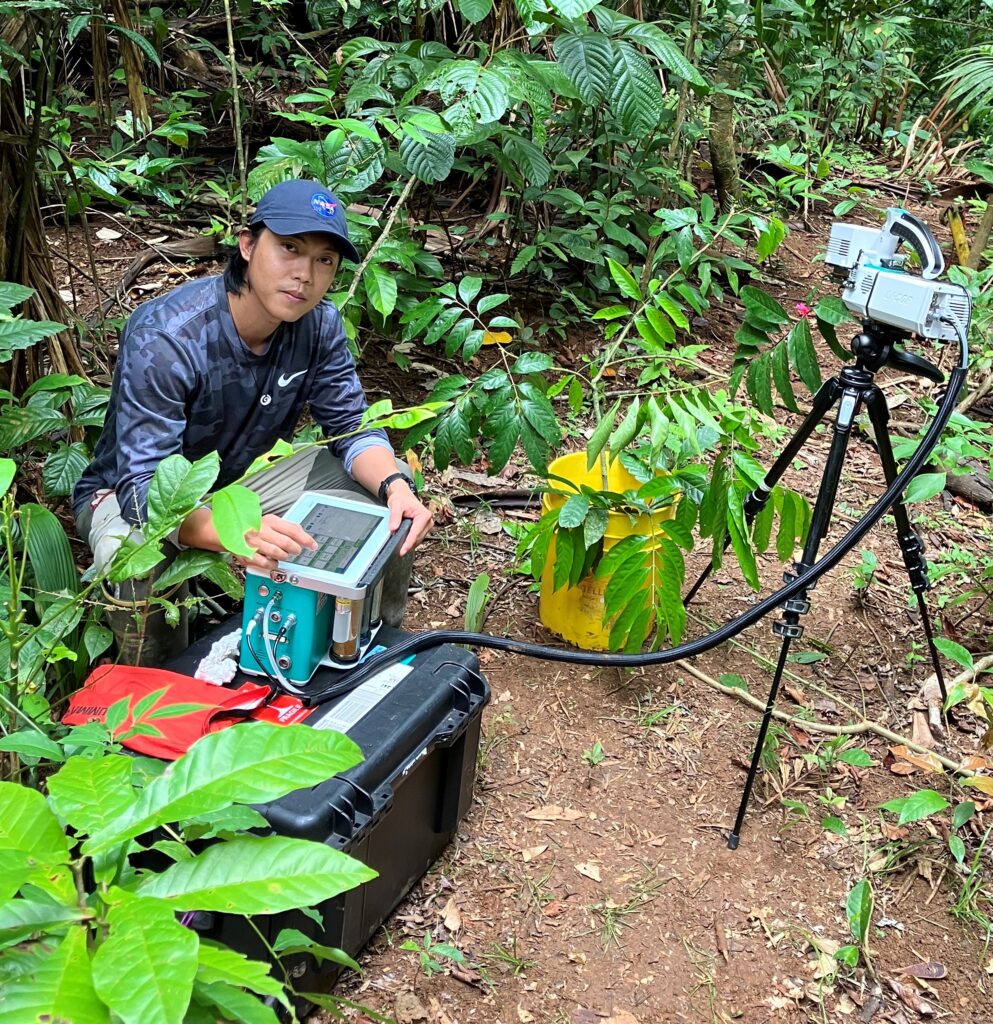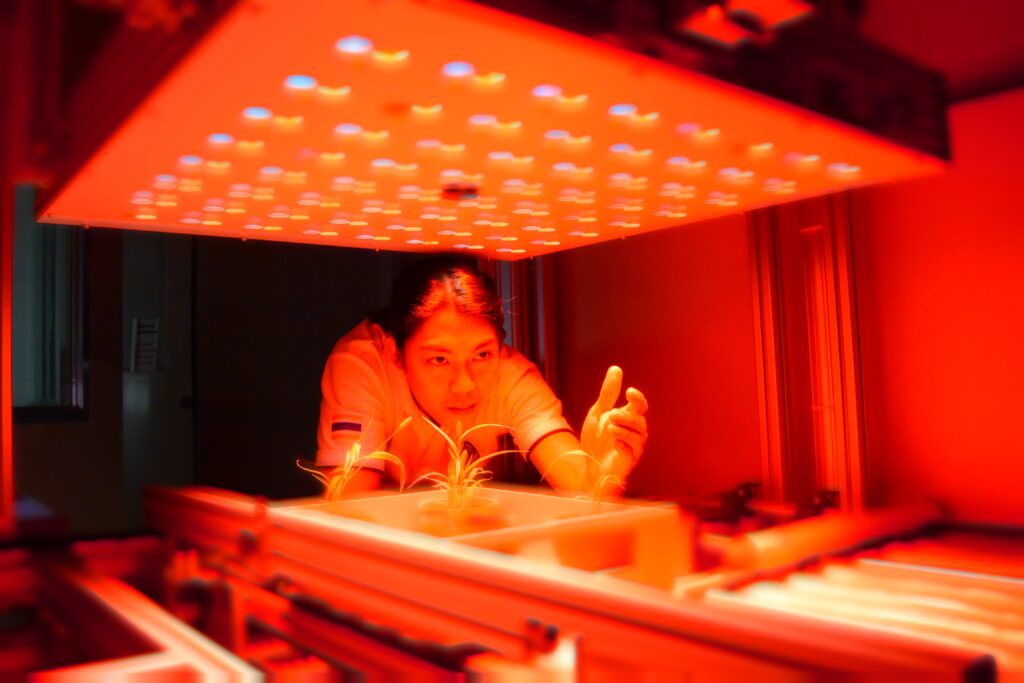by Laila Hurd

We may think we’re familiar with photosynthesis—the textbook recipe plants use to make food from light, water and carbon dioxide (CO2). But measuring it, particularly in natural settings, requires factoring in complex variables. Kelvin Acebron is a postdoc in the Quantitative Ecology Lab at the Smithsonian Environmental Research Center. He’s spent the last decade measuring photosynthesis and studying its regulation in the field. In this Q&A, Kelvin discusses photosynthesis in agriculture and in plants’ natural habitats (like tropical forests). He also shares what he’s learned in his global scientific journey. This interview has been edited and condensed for clarity.
Why is it important to understand how photosynthesis works in nature?
We know in the field, light intensity changes from morning, midday to afternoon. Relative humidity varies from one location to another. Wind speed is dynamic. And then you have this cloud that passes through occasionally, which of course changes the light intensity sometimes pretty abruptly. Plus, there’s shadowing of the leaf from the upper part of the canopy or from taller plants, that creates a fluctuating light environment to the lower part of the canopy or under canopy of the forest. It begs the question of: What is then the photosynthesis on a whole plant level, of the whole ecosystem? And how do we measure and integrate all these dynamic responses?
I heard from a scientist in Europe, where I did my Ph.D., that photosynthesis is anything but a steady state—essentially, because the environment is dynamically changing. I wrote my whole Ph.D. dissertation about it. It is important to understand how this process works in nature, because photosynthesis is a basis of essentially all life on Earth. And I think it will help us work our way around how to live sustainably and coexist in nature.
What inspired you to focus your studies on measuring photosynthesis?
It all started when I joined the C4 Rice Project at the International Rice Research Institute (IRRI) based in Los Baños, Philippines. While I fulfilled my role as a researcher in the project, I was also doing my master’s degree in plant breeding….As a plant breeder, I was trained to be critical in spotting phenotypic variations in plants and what makes them superior in the field. After looking at what I consider important plant traits that contribute to their increase in grain yield, I started to get fascinated by this fundamental process of capturing light and converting CO2 into sugar and biomass, ultimately to the grains that we harvest…
The C4 Rice Project wanted to improve the efficiency of photosynthesis in rice by converting its more primitive type of photosynthesis, C3, into a naturally-evolved C4-type (such as that in maize and sorghum) which were argued to be more efficient under warmer and drier conditions. It became an obsession to me to accurately and precisely measure photosynthesis. Turned out, it’s really worth exploring and it’s much more complicated than just clipping a leaf with a handheld device. The intricacies you need to measure and understand photosynthesis has been my motivation for almost 10 years now.
How do you measure photosynthesis?
First, let’s get a quick review of photosynthesis. Broadly speaking, photosynthesis is divided into two main steps: the part where light is converted to chemical energy and the part where CO2 is captured and actually converted into sugars. The amount of CO2 that leaf absorbs is one of the most common and established methods of measuring photosynthesis, but that’s just one side of the story.
On the [other] side, the efficiency of light absorption and conversion to chemical energy can also be inferred by measuring “chlorophyll fluorescence.” In the simplest term, chlorophyll fluorescence is a byproduct of photosynthesis. Leaves have a limited capacity to use their absorbed light for photosynthesis. Plants have to dissipate that excess energy or else they would damage their photosynthetic machinery….They dissipate this excess energy as heat or fluorescence….That [fluorescence] emission has been studied for almost a century now and has been used to measure photosynthesis for several decades by illuminating the leaf with a certain frequency [of light].Then you get a certain frequency of emission [called fluorescence kinetics] that can reflect the status of photosynthesis.

How does your research connect to the larger conversation on climate change?
Now that we’re facing these climate change scenarios, drought is becoming a big threat, not just in agriculture but in other biomes like the forest.…There’s a lot of scientific debate happening in how plants, through photosynthesis and transpiration, will actually respond to different climate change scenarios that our models tend to predict. There’s lots of things going on when we talk about tropical forests: how climate change is going to affect the diversity of species, the mortality and growth of species. Does CO2 actually fertilize plants in the long run?…
Those are questions still open and debatable in a lot of scientific discussions, and understanding photosynthesis is very central in that. My research on measuring and quantifying photosynthesis at different spatial and temporal scales will enable us to make better predictions of the Earth’s climate in the near future and how different types of ecosystems respond to these changes. I believe these can effectively guide us on how we should manage our forested and agricultural ecosystems under a more sustainable future for all life on Earth.
Is there anything that’s especially surprised you in your work?
What surprised me is that every place I go has different cultures in terms of research. This may actually sound controversial, but I’d like to think that it’s one of the good elements in science.
Even if we pursue science as a way for universal truth, whatever you’re researching about, everybody has their own ways to do that and to arrive in their conclusion. And that was initially surprising and eye-opening because there’s not only one way to see the truth.
Any advice you would give to aspiring scientists, or scientists who are just starting out in their careers?
The biggest advice I have for young scientists is to keep their curiosity and have an open mind….When you’re genuinely curious, that means you have to really ask the questions deeply and have the seriousness or eagerness to find the answer. And so whatever that answer is, whether it’s opposing your current understanding of the world or not, or your political point of view, you have to keep an open mind for you to grow, not just as a good scientist, but as a better person. Those two things go a really long way.
Meet More SERC Scientists
Shelley Bennett: What’s “Normal” Eating in a Maryland Forest?
Rebecca Hale: City Streams and the Future of Urban Ecology
Justin Nowakowski: The Global Zoologist
Genevieve Noyce: Experimenting on the Wetlands of 2100

